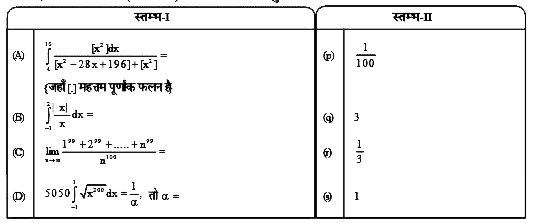यदि x=∫t20{2tan√z+1−tan2√z2√zsec2√z}dz तथा y=∫t20{1−tan2√z−2tan√z2√zsec2√z}dz है , तो t=π4 का वक्र की स्पर्श रेखा का झुकाव होगा -
π4
π3
π2
3π4
The correct Answer is:D
Step by step video, text & image solution for यदि x =int _(0) ^(t^(2)) {( 2 tan sqrt(z) + 1 - tan^(2) sqrt(z))/(2 sqrt(z) sec^(2) sqrt(z))} dz तथा y = int_(0) ^(t^(2)) {(1 - tan ^(2) sqrt(z) - 2 tan sqrt(z))/(2 sqrt( z) sec ^(2) sqrt(z))} dz है , तो t = (pi)/( 4) का वक्र की स्पर्श रेखा का झुकाव होगा - by Maths experts to help you in doubts & scoring excellent marks in Class 12 exams.
Topper's Solved these Questions
- BOOK - ALLEN HINDICHAPTER - DEFINITE INTEGRATIONEXERCISE - Exercise - 03 (सत्य / असत्य)6videos
DEFINITE INTEGRATION
- BOOK - ALLEN HINDICHAPTER - DEFINITE INTEGRATIONEXERCISE - Exercise - 03 (स्तम्भ सुमेलन)3videos
DEFINITE INTEGRATION
- BOOK - ALLEN HINDICHAPTER - DEFINITE INTEGRATIONEXERCISE - Exercise - 01 (सही विकल्पों के चुनिए एक या एक से अधिक सही उत्तर है)9videos
DEFINITE INTEGRATION
- BOOK - ALLEN HINDICHAPTER - CONTINUITY EXERCISE - EXERCISE -05 [B] (JEE-ADVANCED: PREVIOUS YEAR QUESTIONS)2videos
CONTINUITY
- BOOK - ALLEN HINDICHAPTER - DETERMINANTEXERCISE - DO YOURSELF -91videos
DETERMINANT
Similar Questions
समाकल ∫0−∞x.exdx का मान परिमित नहीं होता
02:08View Solutionनिम्न प्रश्न में दो स्तम्भ में वत्क्व्य (statements) दिये गए है जिनका सम्मेलन (match) करना है । स्तम्भ - I(Column-I) के वत्क्व्यो को A, B, C तथा D नामित किया गया है जबकि स्तम्भ -II - (Column-II) के वत्क्व्यो को p,q, r तथा s नामित किया ज्ञात है। स्तम्भ- I (Column-I ) में दिए गए कोई एक वत्क्व्य स्तम्भ -II (Column-II ) के एक वत्क्व्य से सही सुमेल करता है।
 03:36View Solution
03:36View Solution∞∫0x(1+x)(1+x2)dx
01:05View Solutionफलन f(x)=⎧⎨⎩e1/x−1e1/x+1जबx≠01जबx=0 का x=0 पर सततता का परीक्षण कीजिए।
10:09View Solutionसमीकरण निकाय λx+y+z=0,−x+λy+z=0,−x−y+λz=0 का एक अशून्य हल होगा यदि λ का वास्तविक मान है
06:26View SolutionIf sqrt(x+1)+sqrt(y)+sqrt(z-4)=(x+y+z)/(2), then find x+y+z
05:30View Solutiontan ^ (- 1) ((sqrt (x (x + y + z))) / (yz)) + tan ^ (- 1) sqrt ((y (x + y + z)) / (xz)) + tan ^ (- 1) (sqrt ((z (x + y + z)) / (xy))) = pi
06:48View SolutionTan−1yzx√x2+y2+z2+tan−1(zx)y√x2+y2+z2+tan−1(xy)z√x2+y2+z2=
06:53View SolutionIf ex=√1+z−√1−z√1+z+√1−z and tan(y2)=√1−z1+z then the value of dydx at z=1 is equal to to
05:48View SolutionSolve l=∫−sin4tcos4t√f(z)dz√f(cos2t−z)+√f(z)
03:46View SolutionIf tan−1x+tan−1y+tan−1z=π2andx+y+z=√3
then show that x=y=z.07:49View SolutionFor x,y,z,t∈R, if sin−1x+cos−1y+sec−1z≥t2−√2π⋅t+3π, then the value of tan−1x+tan−1y+tan−1z+tan−1(√2πt) is __________.
03:24View SolutionIf x=∫tantc2tan−1zdz,y=∫√tncos(z2)zdx then dydx is equal to : (where c and n are constants) :
05:02View SolutionIf x=∫t20e√z{2tan√z+1−tan2√z2√zsec2√z}dz and x=∫t20e√z{1−tan2√z−2tan√z2√zsec2√z}dz : Then the inclination of the tangent to the curve at t=π4 is :
05:02View SolutionProve that :
tan−1[√1+z+√1−z√1+z−√1−z]=π4+12cos−1z06:19View Solution

